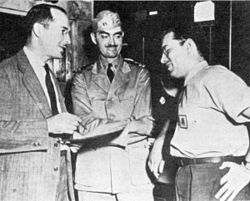Isaac Asimov
Isaac Asimov (c. January 2, 1920[a] – April 6, 1992) was a writer of science fiction.[1] He was also a biochemist with a PhD from Columbia University.
Isaac Asimov | |
|---|---|
 | |
| Native name | Russian: Айзек Азимов |
| Born | c. January 2, 1920[a] Petrovichi, Klimovichskiy Uyezd, Russian SFSR |
| Died | April 6, 1992 (aged 72) Brooklyn, New York City, U.S. |
| Occupation | Writer, professor of biochemistry |
| Citizenship | Russian (early years), American |
| Education |
|
| Alma mater | Columbia University |
| Genre | Science fiction (hard SF, social SF), mystery |
| Subject | Popular science, science textbooks, essays, literary criticism |
| Literary movement | Golden Age of Science Fiction |
| Years active | 1939–1992 |
| Spouse |
|
| Children | 2 |
| Signature |  |
| Scientific career | |
| Fields | Biochemistry |
| Institutions | Boston University |
| Thesis | The kinetics of the reaction inactivation of tyrosinase during its catalysis of the aerobic oxidation of catechol (1948) |
| Other academic advisors | Robert Elderfield (post-doctoral) |
Life
Asimov was born in Petrovichi, Smolensk Oblast, Russian SFSR to a Jewish family, on an unknown date between October 4, 1919 and January 2, 1920. Asimov celebrated his birthday on January 2.[a] He was taken to the United States when he was three, and learned English and Yiddish as his native languages.[2][3][4] He wrote many books. People know about Isaac Asimov because of his science fiction books and his science books for non-scientists.
Writing
Asimov's most famous books were the Foundation series. He also wrote the Galactic Empire, the Robot Series, mystery, fantasy, and non-fiction books. He wrote the Norby series with his wife, Janet Asimov. He wrote or edited over 500 books and about 90,000 letters. Other subjects he wrote about were history, the Bible, literature, and sexuality.
Many of Asimov's early writings were short stories published in cheap science fiction and fantasy magazines. Years later, most of them were collected and republished as collections. Well-known collections include I, Robot, The Rest of the Robots, Earth is Room Enough and The Early Asimov.
Asimov's reading list
Asimov made a list of 15 of his science fiction books, which he advised should be read in this order:
- I, Robot (1950). Alternatively, The Complete Robot (1982).
- Caves of Steel (1954).
- The Naked Sun (1957).
- The Robots of Dawn (1983).
- Robots and Empire (1985).
- The Currents of Space (1952).
- The Stars, Like Dust (1951).
- Pebble in the Sky (1950).
- Prelude to Foundation (1988).
- Forward the Foundation (1993).
- Foundation (1951).
- Foundation and Empire (1952).
- Second Foundation (1953).
- Foundation's Edge (1982).
- Foundation and Earth (1986).
Numbers 1–5 are 'Robot' books; 6–8 are 'Galacticos Empire' books; 9–15 are Foundation series books.[5]
Asimov's novels have influenced science fiction on television and movie. Especially his 'Three Laws of Robotics' is a lasting contribution to our thinking.
- A robot may not injure a human being or, through inaction, allow a human being to come to harm.
- A robot must obey any orders given to it by human beings, except where such orders would conflict with the First Law.
- A robot must protect its own existence as long as such protection does not conflict with the First or Second Law.
Beliefs
Death
When he had heart surgery in 1983, he received blood infected with HIV. He developed AIDS, and died of the effects of the medical condition in 1992. His widow did not speak of this until years later.[7]
Isaac Asimov Media
Robert A. Heinlein, L. Sprague de Camp, and Asimov (left to right), Philadelphia Navy Yard, 1944
The first installment of Asimov's Tyrann was the cover story in the fourth issue of Galaxy Science Fiction in 1951. The novel was issued in book form later that year as The Stars Like Dust.
The first installment of Asimov's The Caves of Steel on the cover of the October 1953 issue of Galaxy Science Fiction, illustrated by Ed Emshwiller
Related pages
Notes
- ↑ 1.0 1.1 1.2 Asimov, Isaac. In Memory Yet Green. p. 31.
The date of my birth, as I celebrate it, was January 2, 1920. It could not have been later than that. It might, however, have been earlier. Allowing for the uncertainties of the times, of the lack of records, of the Jewish and Julian calendars, it might have been as early as October 4, 1919. There is, however, no way of finding out. My parents were always uncertain and it really doesn't matter. I celebrate January 2, 1920, so let it be.
References
- ↑ Isaac Asimov on IMDb
- ↑ Asimov, Isaac 2002. It's been a good life. Janet Asimov, ed. Amherst, New York: Prometheus Books. p12 ISBN 1-57392-968-9.
- ↑ Asimov, Isaac 1994. I. Asimov: a memoir. Bantam Books. p2–3 ISBN 0-553-56997-X
- ↑ Asimov, Isaac 1979. In memory yet green. Avon Books. p32 ISBN 0-380-75432-0
- ↑ 15-Book reading order as suggested by Asimov Archived 2006-05-16 at the Wayback Machine From "Author's Note" of Prelude to Foundation Doubleday 1988 hardcover edition.
- ↑ Free Inquiry (Spring 1982). Wikiquote
- ↑ "Letter from Janet Asimov". Locus Online. Locus Publications. 4 April 2002. Retrieved 2012-12-04.


